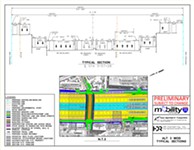Austin at Large: Reading the Palm District
A new plan-of-plans puts the spotlight on Downtown’s hard, rough eastern edges
By Mike Clark-Madison, Fri., Nov. 4, 2022

I have run out of things to say about the 2022 elections: Anyone who can vote this year but doesn't deserves a spanking. So let's talk about city stuff! Remember the Palm District? It first emerged as a City Hall concept in the Before Times of 2019, amid disputes over the future of the historic Palm School at I-35 and East Cesar Chavez, which is owned by Travis County. (The "Palm" name that graces the former school, and the adjacent park, and a current AISD campus near McKinney Falls, refers not to a tree but to a Swedish nobleman; many of his compatriots settled in and near the new Palm District back in the 19th century, including the neighborhood of Swede Hill where I live and where, at Oakwood Cemetery, Sir Svante Palm is buried.) The district was a way for City Hall, by which I mean Kathie Tovo, to make sense of the ambitious plans and projects to transform, in various ways, the eastern edge of Downtown, which even after floods of boom dollars can still be a bit hard and rough. Those would include a new and different Austin Convention Center, the full flowering of the Waterloo Greenway, an ever-livelier Red River Cultural District and an ever-taller Rainey Street, and at its north end the Innovation District around the former Brackenridge Hospital campus and anchored by the growing UT Dell Medical School. There are also more uncertain forces in the area: the city's beleaguered emergency shelters for the unhoused; its unbeloved but also un-redevelopable police headquarters, where more than a dozen people were maimed by the cops during 2020 protests; the fast-fraying cultural fabric of the Mexican American community that for 80 years sent its kids to Palm School; and the disruption to come from the rebuilding of I-35, no matter how that's designed.
Let’s Plan Before We Act
For additional context, back in 2019 Mayor Steve Adler was still working through his "Downtown puzzle" concept that aimed to direct money from hotels toward homelessness, then-County Judge Sarah Eckhardt was ready to sell Palm School (whose historic structure is protected by deed restrictions) to the highest bidder and reinvest the proceeds in the district (and using hotel bed tax funds to upgrade the Expo Center in far East Austin), and community champion and former school trustee Paul Saldaña was lobbying Tovo and City Hall hard to make Palm School an anchor of a Chicano cultural district that would stretch down to the Emma S. Barrientos Mexican American Cultural Center on Rainey and then east along the lake. Eventually, Council settled on calling for a plan for the Palm District that reflected all these considerations, which got delayed by COVID et al. but is now complete and ready for consideration by the Planning Commission on Nov. 8 and Council on Dec. 1, at last report.
The plan produced, led by the city's Housing and Planning Department and a consulting team led by Asakura Robinson, one of Austin's higher-quality urban design shops, reflects back to the various committed community stakeholders what they wanted to see more of in the area. It manages to do this without raising much sand about the goals and priorities of individual players whose existing visions need to be accommodated in the new district, which is an interesting outcome considering that the beginning of this planning process was fraught with lamentations about the gentrification and displacement and erasure and inequity and injustice suffered, most of all, by the Mexican American community.
But Let’s Act Before We Die
That grieving is real, but those things did not just happen due to unstoppable natural forces. From the first settlers who ran off the Tonkawa people, someone, usually someone white, decided that the everyday lives of the mostly nonwhite people (Chicano and Black but also Chinese and Lebanese) along East Avenue and Waller Creek did not represent the highest and best use of those properties, over and over. Often, what was deemed more useful to Austin at large was an undesirable land use, from the early slaughterhouse district along the creek, to the hospital campus that was built after 13 acres of neighborhood was destroyed through "urban removal," to the Salvation Army men's shelter and the Austin Resource Center for the Homeless in our own day. And, of course, the highway.
In our day, this corridor that fronts the central core of the Most Interesting City in the World is way too expensive for unpleasant land uses like a big highway, which means it's also too expensive for most working-class people of color. With its vision built on the four pillars of "inclusive growth, culture, connections, and nature," we'll see how much influence this Palm District Plan has on what the powers that be in Austin today plan to do.
Got something to say? The Chronicle welcomes opinion pieces on any topic from the community. Submit yours now at austinchronicle.com/opinion.







